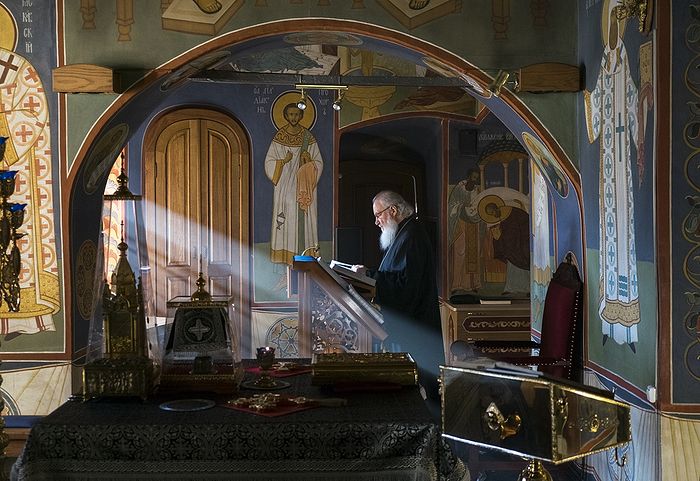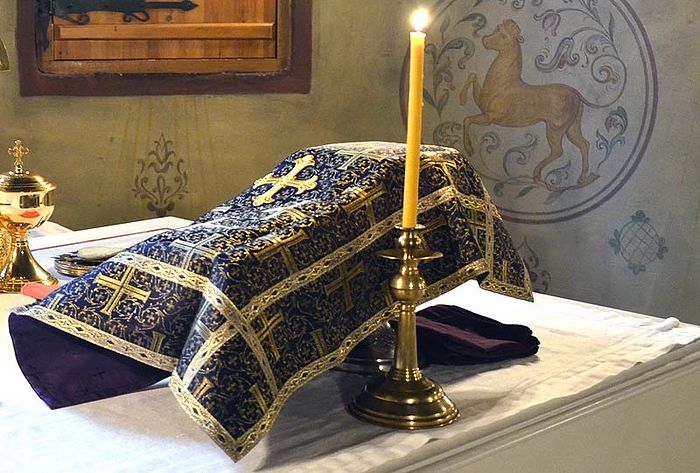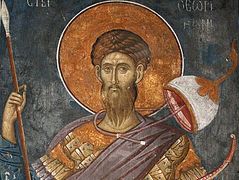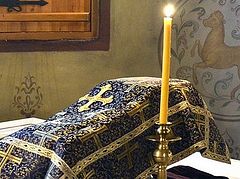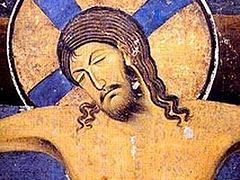The Eucharist is not celebrated on weekdays of Great Lent; the change of the bread and wine into the Flesh and Blood of our Lord Jesus Christ does not occur in the altar in the church. But on Wednesdays and Fridays, we still have the chance to commune of the Holy Gifts, consecrated earlier at the Sunday Divine Liturgy. On Wednesday and Friday, and also on polyeleos-rank feasts that fall in Great Lent, and on Thursday of the fifth week (the day of the Great Canon) a special Great Lenten service is celebration: The Liturgy of the Presanctified Gifts. In this article, professor of the Saratov Orthodox Theological Seminary and author of the textbook The Typikon of Orthodox Worship Alexei Kashkin tells us about the Presanctified Liturgy.
—Alexei Sergeevich, where does such an interesting tradition come from—to commune the people of the previously-consecrated Gifts in Great Lent? And why specifically on Wednesday and Friday?
—The tradition comes from the ancient custom of self-communing—in the era of Christian persecution, they would prepare a larger Lamb for the Eucharist than was required for the communing of the congregation; and at the end of the gathering they would take a particle with them to commune at home—in the event that the next gathering simply didn’t happen. Later this custom was adopted by hermits—they would take the Holy Gifts with them, going out into the desert. But only in the sixth century did private self-communing turn into the common Church communing of the previously prepared Gifts. The rite of the Liturgy of the Presanctified Gifts first appeared in Antioch. The tradition later took root in Constantinople. For a long time, the Presanctified Liturgy was celebrated only on Holy Friday, and then began to spread to the weekdays of Great Lent. Note that the full Liturgy is still not served on Holy Friday—the bloodless sacrifice is impossible on a day when we commemorate the bloody sacrifice on Golgotha; but now the Presanctified Liturgy is not served on Holy Friday either.
Why were Wednesday and Friday chosen out of the Lenten weekdays? It would be more correct to say that Thursday and Saturday were chosen. According to ancient tradition, which today is certainly not followed everywhere, the Liturgy of the Presanctified Gifts is celebrated in the evening, in conjunction with Vespers, and it relates to the following, coming day. Saturday is a special, pre-feast day, and Thursday was chosen either simply as the middle of the week, or due to the monastic typikon prohibiting eating on Monday and Tuesday of the first week of Great Lent; you could eat only on Wednesday evening. Therefore, the Liturgy could be served no earlier than Wednesday.
—If at the beginning of the full Liturgy, the offering of the Holy Gifts is on the altar, where are the Presanctified Gifts before the beginning of this special, Great Lenten Liturgy?
—Where the Lamb, Who gave Himself as an offering, should be: on the altar. The Gifts are already sanctified, therefore the proskomedia—the preparatory part of the Liturgy—is omitted. After the exclamation “Blessed is the Kingdom,” the opening 103rd psalm and the Great Litany, or Litany of Peace (“In peace let us pray to the Lord…”), is read in church, and the appointed evening kathisma. It should be noted that the Presanctified Liturgy is inseparably united with Vespers and contains parts of it in it, which is why a kathisma and the paroemia are read, which are never read during the full Divine Liturgy: They are elements precisely of the evening service. During the reading of the first part of the kathisma (the first “Glory”), the priest takes the Lamb out of the artophorion on the altar, lays it on the diskos and places the diskos on the antimens. During the second “Glory,” the Lamb is censed on the altar; during the third the priest, preceded by the deacon censing the Holy Gifts, transfers the Lamb through the High Place (that is, not leaving the altar) to the table of oblation. The Royal Doors are closed during this. When we hear “Lord, I call upon thee…” (140th, 141st, 129th, and 116th psalms), the Gifts are already on the table of oblation. The deacon, having taken the priest’s blessing, pours wine and water into the chalice. The priest places the star on the diskos with the Lamb, covers the chalice and diskos with the veil, and both together with the aer. During all of these sacred actions, the priest says, “Let us pray to the Lord,” and the deacon answers, “Lord have mercy.” Note that the proskomedia (the preparatory part) in the usual, full Liturgy is accompanied by many more texts, including the reading of fragments of Isaiah and the Gospel of John. The priest’s brevity in this case is due to the fact that they are dealing not just with an earthly substance, but with a sacred object.
—And during the Presanctified Liturgy, there’s no Little Entrance or Entrance with the Gospel?
—It happens, but only in Holy Week or in the case of a polyeleos feast (The First and Second Findings of the Precious Head of St. John the Forerunner—February 24/March 9; the memory of the Forty Martyrs of Sebaste—March 9/22), when the Gospel is read during the Presanctified Liturgy. The Gospel is not read on weekdays of the Holy Forty Days (remember, Holy Week is not included in the Forty Days). However, there is an entrance with the censer—according to the rite that we know from Vespers. Then we hear the beloved “O Gladsome Light”—this is also an element of Vespers.
—Let’s talk about the reading of the paroemia—the Old Testament texts…
—The paroemia are read in church every weekday in Great Lent: at the Liturgy, if it is served, or at Vespers. It’s an ancient practice: Lent, in the ancient Church (beginning in the fourth century), was a period of catechesis, of preparation for Baptism for the catechumens. St. John Chrysostom says in his talks on the book of Genesis: “The Holy Forty Days has begun, and we will be reading the book of Genesis.” And there’s a peculiarity to the reading of the paroemia at the Liturgy: Between the two readings, the deacon, with lit candle in his hands, exclaims “The light of Christ illumines all.” This is one of the ancient elements of the Liturgy of the Presanctified Gifts; it’s connected with the custom of carrying the lamp into the liturgical gathering.
—Another exciting feature about this Great Lenten Liturgy: the kneeling chant “Let My Prayer Arise,” when the choir descends from the kliros to the middle of the church…
—“Let My Prayer Arise”—it’s one of the ancient hymns of the Liturgy of the Presanctified Gifts; in reality, it’s a Great Prokimenon, consisting of verses from the 140th psalm. Since ancient times, tradition prescribed for the canonarch to sing it in the middle of the church. The priest is censing at this time, which corresponds to the words “in Thy sight as incense.” Theodoret of Cyrrhus mentioned this custom already in the fifth century. The kneeling, called for by the Typikon, speaks to the special, intensified prayer. Here we hear the words “Set a watch, O Lord, before my mouth,” which are so important for us if we want to attain a spiritual state that corresponds to Great Lent: “…Incline not my heart unto evil words.”
After “Let My Prayer Arise,” there are three prostrations before the already-consecrated Gifts as we read the Great Lenten prayer of St. Ephraim the Syrian “O Lord and Master of my life.”
—The Great Entrance (transferring the Holy Gifts from the table of oblation to the altar) at the Liturgy of the Presanctified Liturgy differs from the Great Entrance at the “usual,” or full, Liturgy, in that here it is not just an offering that is brought into the altar, that is, not just an earthly substance that awaits becoming the Flesh and Blood of the Lord, but precisely His Flesh; we can say—He Himself. Is this why the Cherubic Hymn is replaced by the hymn, “Now the Powers of Heaven Do Serve Invisibly With Us”?
—Yes, and we read about this in liturgical manuscripts from as early as the seventh century. “Lo, the King of Glory enters. Lo, the mystical sacrifice is upborne, fulfilled”—the sacrifice is not to be completed in the future, but is already fulfilled. The fulfilled sacrifice is solemnly carried into the altar. All those present in the church prostrate to the ground. After “Our Father…” and the exclamation “The presanctified Holy Things are for the holy,” the Lamb is fragmented in the altar, and the clergy commune. Then the laity commune.
By the way, there is a very interesting action, not called for by the Typikon, but done in practice: After the Great Entrance, the deacon closes the curtain only halfway. Just think about it: Of all of the services of the daily (and annual) cycle, this half-closing of the curtain is done only at the Liturgy of the Presanctified Gifts! Liturgists explain the meaning of this action as: On the one hand, after the Great Entrance, the altar symbolizes the sealed tomb of Christ, therefore the curtain should be closed. On the other hand, it’s necessary that the faithful have the opportunity to see the Gifts on the altar, so the curtain should be open. At the full Liturgy, the curtain is initially closed after the Great Entrance until the Creed, then it is opened and left open until the communing of the clergy. At the Liturgy of the Presanctified Gifts, the interval from the Great Entrance until the communing of the clergy is very short, therefore, in the end, they chose a compromise position: The curtain is partially closed, and partially open.
—Everyone knows that infants do not commune at the Liturgy of the Presanctified Gifts, as they are unable to receive a piece of the Body, but only a drop of the Blood, but the wine with water in the chalice is not the Blood of the Lord; the piece of the Lamb—the Flesh of Christ—is placed just into wine with water…
—Yes, such a conviction found expression in the modern liturgical practice of the Russian Church. That is why the priest, consuming the Holy Gifts in the altar, does not drink from the chalice immediately upon communing. But there is another point of view: The Greeks believe that the transubstantiation of the wine into Blood is completed by the placing of the piece of the Lamb into the chalice. Therefore, in the Greek East, priests commune from the chalice at the Liturgy of the Presanctified Gifts, and there is the practice of communing children.
After the communing of the laity, instead of the hymn more familiar to us, “We have seen the true light, we have received the Heavenly Spirit, we have found the true faith…” we hear “Taste the heavenly bread and the cup of life.” It is also noteworthy that the prayer behind the ambo changes: Instead of “O Lord, who dost bless them that bless Thee,“ the priest says “O Almighty Master,” which includes the words: “Grant unto us also, O Good One, to fight the good fight, to complete the course of the Fast, to preserve the Faith undivided, to crush the heads of invisible serpents, to be shown to be conquerors of sins and, without condemnation, also to attain to and to worship the holy Resurrection…”

